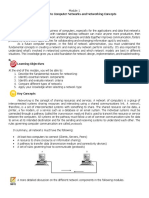computer network
A computer network is a system that connects two or more computing
devices, enabling them to share resources and communicate with each
other. These devices, which can include computers, servers, printers, and
other hardware, exchange data using standardized protocols and
transmission media, like cables or wireless signals. Networks facilitate
various applications such as file sharing, email, and internet access.
Core Concepts:
Interconnected Devices: Networks involve the connection of multiple
devices, allowing them to interact and exchange information.
Resource Sharing: Networks enable the sharing of resources like files,
printers, and applications, eliminating the need for individual copies on each
device.
Communication: Devices communicate using standardized protocols (like
TCP/IP), ensuring smooth and reliable data exchange.
Physical and Wireless Connections: Networks can be established using
physical cables (like Ethernet) or wireless technologies (like Wi-Fi).
Nodes:Individual devices within a network are often referred to as nodes.
Examples:
Local Area Network (LAN): A network within a limited area, like a home
or office.
Wide Area Network (WAN): A network spanning a large geographical
area, like the internet.
Benefits:
Efficiency: Sharing resources and information streamlines workflows and
reduces redundancy.
Collaboration: Networks facilitate collaboration through shared
documents, applications, and communication tools.
Cost-Effectiveness: Sharing hardware resources can significantly reduce
costs.
Communication: Networks enable various forms of communication,
including email, messaging, and video conferencing.
Data Management: Networks allow for centralized or distributed data
storage and management.
1
�Uses of NETWORKS
Networks, both computer and social, serve various crucial
purposes. Computer networks enable resource sharing, communication,
and efficient data access, while social networks facilitate communication
and relationship building. These uses are integral to both personal and
professional lives, impacting how we work, learn, and connect with
others.
Computer Networks:
Resource Sharing: Networks allow users to share hardware (like printers
and scanners) and software (like applications and databases).
Communication: Networks facilitate various forms of communication,
including email, messaging, video conferencing, and file sharing.
Data Sharing and Access: Networks enable access to information and
data stored on different devices, enhancing collaboration and productivity.
Remote Access: Networks allow users to access resources and information
from anywhere with an internet connection, supporting remote work and
access to online services.
Business Applications: Networks are vital for e-commerce, online banking,
and other business operations.
E-Learning: Networks support online education platforms and access to
educational resources.
Security and Surveillance: Networks can be used to monitor and secure
physical spaces and digital data.
Social Networks:
Communication and Connection: Social networks allow individuals to
connect with friends, family, and colleagues, fostering communication and
relationships.
Information Sharing: Social networks enable the sharing of information,
ideas, and experiences.
Community Building: Social networks can create online communities
based on shared interests or goals.
Professional Networking: Social networks like LinkedIn help professionals
connect, share information, and advance their careers.
2
� Marketing and Business: Businesses use social media for marketing,
advertising, and customer engagement.
Networking Hardware.
Network hardware refers to the physical equipment needed for
communication and interaction between devices on a computer network.
These components are the building blocks of a network infrastructure and
include a variety of hardware types, each serving a specific purpose.
Types of Network Devices
Hub. A hub is a simple connectivity device that connects cables, forming a
network segment.
Switch. A switch is more advanced than a hub. ...
Router. Routers can filter and forward data using logical addresses like IP
addresses. ...
Bridge. ...
Gateway. ...
Repeater. ...
Load Balancer. ...
Modem.
Network software refers to the programs and applications that manage,
control, and monitor computer networks. It enables tasks like setting up
networks, managing users, sharing resources, and ensuring security. Traditional
networks relied on hardware-based systems, but software-defined networking
(SDN) separates control from the underlying hardware, making networks more
adaptable.
Key functions of network software:
Network setup and configuration:
Network software helps in the initial setup and configuration of networks,
including defining network topology and allocating resources.
User and resource management:
3
� It allows administrators to manage user accounts, control access to
network resources, and define data storage locations.
Network monitoring and performance analysis:
Network software monitors network traffic, performance, and security,
identifying potential issues and optimizing resource usage.
Security management:
It provides tools for implementing firewalls, intrusion detection systems,
and other security measures to protect the network from unauthorized
access and cyber threats.
Routing and switching:
Network software manages the flow of data across the network by
overseeing routing and switching processes.
Virtualization:
Network software enables network virtualization, allowing for the
creation of virtual networks on top of physical infrastructure.
Examples of Network Software:
Operating Systems:
Operating systems like Windows Server, Linux, and macOS provide the
foundation for network operations, enabling devices to communicate and
share resources.
Protocol Suites:
Protocols like TCP/IP, HTTP, and FTP define the rules for data exchange
and ensure communication between different devices.
Network Monitoring Tools:
Software like Nagios, OpenNMS, and ManageEngine OpManager help
monitor network performance and identify issues.
Security Software:
Firewalls, VPN software, and intrusion detection systems are examples of
security software used to protect networks.
Software-Defined Networking (SDN) Software:
SDN controllers and applications separate control logic from the
underlying network hardware, enabling dynamic and programmable
network management.
Network Mapping Tools:
4
� Tools like Intermapper allow administrators to visualize and understand
network topology.
Network Asset Management Software:
Software like that provided by Octal IT Solution helps track and manage
network devices.
Benefits of Network Software:
Increased agility:
Network software allows for faster deployment, updates, and
modifications to adapt to changing business needs.
Improved transparency and monitoring:
Network software provides insights into network performance and usage,
enabling proactive issue resolution.
Enhanced security:
Network software helps protect networks from unauthorized access and
cyber threats.
Better resource utilization: Network software optimizes network
performance and resource allocation, leading to more efficient use of
network resources.
The four types of wireless networks -- wireless LAN, wireless MAN, wireless
PAN and wireless WAN
In computer networking, a reference model provides a conceptual framework
for understanding and designing communication systems. These models break
down complex communication processes into layers, each with specific
functions, promoting interoperability between different network components
and technologies. The two most prominent reference models are the OSI model
and the TCP/IP model.
1. OSI Model (Open Systems Interconnection Model):
Purpose: The OSI model is a theoretical framework that standardizes
communication between different network systems.
Structure: It consists of seven layers, each with its own set of functions:
Physical, Data Link, Network, Transport, Session, Presentation, and
Application.
Functionality: Each layer handles specific aspects of communication, such
as physical transmission, addressing, routing, and data formatting.
5
� Benefits: It helps in understanding network functionality, troubleshooting
issues, and developing new network technologies.
2. TCP/IP Model:
Purpose: The TCP/IP model is a practical model that underlies the internet's
communication protocols.
Structure: It has four layers: Network Access, Internet, Transport, and
Application.
Functionality: The layers handle similar functions as the OSI model, but
with a more streamlined approach.
Benefits: It is the foundation of the internet and is widely used in practical
network implementations.
Key Differences:
Layers: OSI has seven layers, while TCP/IP has four.
Focus: OSI is more of a theoretical model, while TCP/IP is more practical and
widely used.
Implementation: Some OSI layers are not explicitly implemented in TCP/IP
(e.g., session layer).
Protocols: TCP/IP is based on specific protocols like TCP and IP, while OSI is
a framework for defining protocols.
The theoretical basis for communication in computer networks revolves
around establishing reliable and efficient data exchange between
devices. This involves defining protocols, understanding transmission media,
and addressing factors like data encoding, error control, and flow control. Key
concepts include the OSI model, which provides a layered approach to
network architecture, and various communication models like simplex, half-
duplex, and full-duplex, dictating the direction and timing of data flow.
1. Communication Models:
Simplex:
Data flows in one direction only, like a one-way street. According to
Indira Gandhi Institute of Technology, Sarang , examples include a
keyboard sending input to a computer or a monitor displaying output.
Half-Duplex:
6
� Both devices can transmit and receive, but not
simultaneously. According to Indira Gandhi Institute of Technology,
Sarang, a walkie-talkie is a common example, where only one person can
speak at a time.
Full-Duplex:
Both devices can transmit and receive concurrently. According to Indira
Gandhi Institute of Technology, Sarang, telephones are an example of
full-duplex communication.
2. Key Components of Communication:
Sender and Receiver: The devices initiating and receiving the data.
Transmission Medium: The physical path (e.g., cable, wireless) through
which the data travels.
Message: The actual data being transmitted.
Protocols: Sets of rules governing how data is transmitted, ensuring both
sender and receiver understand the communication.
3. Protocols and Standards:
TCP/IP: The foundational protocol suite for the internet, providing reliable,
ordered, and error-checked delivery of data according to GeeksforGeeks .
HTTP/HTTPS: Protocols for accessing and transferring web pages, with
HTTPS offering secure, encrypted communication.
SMTP: Used for sending emails.
UDP: Another transport layer protocol, offering faster, connectionless
(unreliable) communication.
4. Data Encoding and Modulation:
Baseband Transmission:Data is transmitted as a sequence of pulses
directly over the transmission medium.
Passband Transmission: Data is modulated onto a carrier signal for
transmission over a specific frequency range.
Modems: Devices that perform modulation and demodulation for passband
transmission.
5. Error Control and Flow Control:
Error Detection and Correction: Protocols include mechanisms to detect
and potentially correct errors introduced during transmission says Bharath
University.
Flow Control: Mechanisms to manage the rate of data transmission,
preventing one device from overwhelming another.
7
� 6. Theoretical Frameworks:
OSI Model: A conceptual framework that divides network communication
into seven layers, each with specific functions.
Network Topology: The physical or logical arrangement of devices in a
network, influencing communication patterns and efficiency.
Queueing Theory: Used to analyze and optimize network performance,
particularly in handling network traffic and delays.
Transmission media in computer networks refers to the physical paths that
carry data signals between devices. These paths can be either guided,
meaning they use physical cables to direct the signal, or unguided, meaning
they transmit signals through the air or space.
Guided Media (Wired):
Twisted Pair Cable: Consists of two insulated copper wires twisted
together to reduce interference. Commonly used in telephone and Ethernet
networks.
Coaxial Cable: Features a central conductor surrounded by an insulator, a
shield, and an outer jacket. Offers better shielding and higher bandwidth
than twisted pair, used in cable TV and some network connections.
Fiber Optic Cable: Uses thin strands of glass or plastic to transmit data as
light signals. Provides high bandwidth, long distance transmission, and
resistance to interference, but can be more expensive and require
specialized installation.
Unguided Media (Wireless):
Radio Waves:Transmit data through the air using radio frequencies. Used
in Wi-Fi, Bluetooth, and other wireless technologies.
Microwaves:Transmit data through focused beams of microwave
radiation. Used for long-distance communication and satellite links.
Infrared:Uses infrared light to transmit data over short distances. Common
in remote controls and some wireless devices.
Wireless transmission in computer networks refers to the communication
between devices using electromagnetic waves (like radio waves, microwaves,
or infrared) instead of physical cables. This allows for greater flexibility and
mobility in device usage, enabling devices to connect and communicate
without being physically tethered.
Key Concepts:
8
�Electromagnetic Waves:
Wireless communication relies on the transmission of data through
electromagnetic waves, which can travel through the air or even some
barriers.
Types of Wireless Transmission:
Radio Waves: Used in Wi-Fi, Bluetooth, and cellular networks,
offering a range of distances and broadcast capabilities.
Microwaves: Require line-of-sight and are often used for long-
distance communication.
Infrared: Used for short-range communication, like remote
controls, and does not penetrate walls.
Wireless Network Technologies:
Examples include Wi-Fi (WLANs), Bluetooth, cellular networks (3G, 4G,
5G), and satellite communication.
Advantages:
Wireless transmission offers flexibility, mobility, and the ability to
connect devices over large areas without the need for physical cabling.
Disadvantages:
Wireless networks can be susceptible to interference, security issues,
and may have limitations in range and bandwidth compared to wired
connections.
Applications:
Wireless transmission is used in a wide range of applications, including:
Home and office networks: Connecting computers, printers, and other
devices via Wi-Fi.
Mobile devices: Smartphones, tablets, and laptops connecting to the
internet via cellular networks or Wi-Fi.
Satellite communication: Providing internet and communication services
in remote areas.
Bluetooth devices: Connecting headphones, speakers, and other
peripherals.
The electromagnetic (EM) spectrum encompasses all types of
electromagnetic radiation, arranged by frequency and wavelength. It
includes a broad range of radiation, from long wavelength, low frequency
9
� radio waves to short wavelength, high frequency gamma rays. Visible
light, which we can see, is just a small portion of this spectrum.
Here's a breakdown of the EM spectrum from longest wavelength/lowest
frequency to shortest wavelength/highest frequency:
Radio Waves: Used for communication, broadcasting, and radar.
Microwaves: Used for cooking, radar, and telecommunications.
Infrared Radiation: Used in thermal imaging, remote controls, and
heating.
Visible Light: The portion of the spectrum we can see, including all the
colors of the rainbow.
Ultraviolet Radiation: Can cause sunburns and is used in sterilization.
X-rays: Used in medical imaging and security screening.
Gamma Rays: High energy radiation with many applications in medicine
and research.
Radio transmission
in computer networks involves using radio waves to send and receive data
wirelessly. This technology enables communication between devices without
physical cables, facilitating various applications like Wi-Fi, Bluetooth, and
cellular networks.
1. Encoding and Modulation:
Data (like voice or computer files) is converted into electrical signals.
These signals are then used to modulate a radio wave, which is a type of
electromagnetic wave.
Modulation means changing either the amplitude, frequency, or phase of
the radio wave to encode the data.
Common modulation techniques include Amplitude Modulation (AM) and
Frequency Modulation (FM).
2. Transmission:
The modulated radio wave is transmitted through the air via an antenna.
Radio waves propagate in all directions (omnidirectional antennas) or in a
specific direction (directional antennas).
3. Reception and Demodulation:
A receiving antenna intercepts the radio waves.
10
� The receiver then demodulates the signal, extracting the original data.
The extracted data is converted back into a usable format.
4. Key Components:
Transmitter: Generates and sends the radio waves.
Receiver: Captures and interprets the radio waves.
Antenna: Radiates and receives the electromagnetic waves.
Modulation/Demodulation: The process of encoding and decoding data
onto the radio wave.
5. Applications:
Wi-Fi: Enables wireless internet access within a limited area.
Bluetooth: Allows short-range wireless communication between devices,
like headphones and smartphones.
Cellular Networks: Provides mobile phone and internet access over a
wide area.
Radio Broadcasting: Transmits audio and video signals to a wide
audience.
Remote Controls: Controls devices like garage doors and televisions.
6. Advantages:
Mobility: Allows devices to move around without being tethered to a
cable.
Ease of Installation: Wireless networks are generally easier to set up
than wired networks, especially in areas where cables are difficult to run.
Flexibility: Radio waves can travel through walls and other obstacles
(depending on the frequency and power).
7. Challenges:
Interference: Radio waves can be affected by other signals, causing
interference and errors.
Security: Data transmitted over radio waves can be more vulnerable to
interception than wired connections.
Limited Range: The range of radio transmission is limited by factors like
frequency, power, and obstacles.
11
� Digital modulation in computer networks is the process of encoding digital
data onto a carrier signal for transmission over a communication
medium. This involves varying a carrier wave's amplitude, frequency, or
phase to represent binary data (0s and 1s). It's crucial for efficient and
reliable data transmission in various communication systems.
1. What it is:
Digital modulation transforms digital data (like those from a computer)
into a form suitable for transmission over physical channels (like cables or
radio waves).
It maps discrete digital signals (0s and 1s) to specific characteristics of a
carrier wave.
This process allows for the transmission of digital information over various
media, including wired and wireless networks.
2. Why it's used:
Efficient data transmission: Digital modulation enables the efficient use
of bandwidth and power resources, allowing for higher data rates.
Improved noise immunity: Digital modulation techniques, like PSK and
FSK, offer better resistance to noise and interference compared to analog
modulation.
Compatibility with digital systems: It facilitates seamless integration
with digital devices and systems, simplifying network design and operation.
Enhanced security: Digital modulation can incorporate encryption and
other security measures, making data transmission more secure.
3. Key Digital Modulation Techniques:
Amplitude Shift Keying (ASK): Changes the amplitude of the carrier
signal to represent binary data.
Frequency Shift Keying (FSK): Alters the frequency of the carrier
signal to represent binary data.
Phase Shift Keying (PSK): Modifies the phase of the carrier signal to
encode digital information.
Quadrature Amplitude Modulation (QAM): Combines amplitude and
phase modulation to achieve higher data rates.
4. Digital Modulation vs. Analog Modulation:
Digital modulation: Uses discrete, defined levels for the carrier signal's
characteristics.
12
� Analog modulation: Uses continuous, variable levels for the carrier
signal's characteristics.
Digital modulation is generally preferred for modern communication
systems due to its advantages in terms of noise immunity, bandwidth
efficiency, and integration with digital devices.
5. Role in Computer Networks:
Digital modulation is essential in various network components, including:
o Modems: Devices that modulate and demodulate signals for transmission
over telephone lines or other media.
o Wireless routers and access points: Modulate and demodulate signals
for Wi-Fi and other wireless communication.
o Network interface cards (NICs): Handle the modulation and
demodulation of signals for wired network connections.
Baseband transmission in computer networks refers to the transmission of
digital signals in their original, unmodulated form over a single channel,
where the entire bandwidth of the medium is used to carry a single signal at a
time. This means that no carrier frequency modulation is used, and the signal
is transmitted directly at its base frequency.
Key Characteristics of Baseband Transmission:
Single Channel:
Only one signal occupies the entire bandwidth of the transmission
medium (e.g., a cable) at any given time.
Digital Signals:
Baseband transmission is inherently digital, meaning data is represented
as a series of discrete voltage levels.
Unmodulated:
The signal is transmitted at its original frequency, without being
modulated onto a higher frequency carrier wave.
Short Distances:
Baseband transmission is typically used for short-distance
communication due to signal attenuation and bandwidth limitations.
Time Division Multiplexing (TDM):
13
� While only one signal occupies the channel at a time, multiple devices
can share the same medium using TDM, where each device gets a slice
of time to transmit.
Examples:
Ethernet local area networks (LANs) often utilize baseband transmission.
How it works:
In baseband transmission, a digital signal (a stream of 0s and 1s) is
directly converted into voltage pulses. For instance, a high voltage might
represent a '1' and a low voltage a '0'. These voltage pulses are then
transmitted over the medium.
Advantages of Baseband Transmission:
Simplicity: Baseband systems are relatively simple to implement
compared to broadband systems.
Cost-effectiveness: Simpler hardware and fewer components can lead
to lower costs.
Low Bandwidth Requirement (for a single device): When only one
device is transmitting, the entire bandwidth is available to it.
Disadvantages of Baseband Transmission:
Limited Distance:
Signal attenuation over longer distances can significantly reduce the
quality of the signal, requiring repeaters to amplify the signal.
Limited Simultaneous Users:
Due to the single channel, only one device can transmit at a time unless
TDM is employed.
Not Suitable for Video:
Baseband transmission is not generally used for video signals due to
their high bandwidth requirements and sensitivity to interference.
Baseband vs. Broadband:
The key difference between baseband and broadband transmission lies in
how the signal is transmitted:
Baseband: Transmits the original, unmodulated signal over a single
channel.
Broadband: Uses modulation techniques to transmit multiple signals
simultaneously over different frequency ranges within the same medium.
14
� OSI Reference Model
The OSI (Open Systems Interconnection) model is a conceptual framework
that standardizes the functions of a computer network into seven layers,
facilitating communication between different systems. It provides a
common language for understanding and troubleshooting network
operations, even though the internet primarily uses the TCP/IP model.
1. Physical Layer:
Deals with the physical medium for transmitting data (cables, signals).
2. Data Link Layer:
Packages data into frames, manages access to the physical medium, and
ensures error-free transmission between adjacent nodes.
3. Network Layer:
Responsible for routing data packets across networks, determining the
best path for transmission.
4. Transport Layer:
Provides reliable or unreliable data delivery between applications,
managing segmentation and flow control.
5. Session Layer:
Establishes, manages, and terminates connections (sessions) between
applications.
6. Presentation Layer:
Handles data formatting, encryption, and compression, ensuring data is
in a usable format for the application layer.
7. Application Layer:
The interface between the user and the network, providing access to
network services (e.g., email, web browsing).
15






























































































